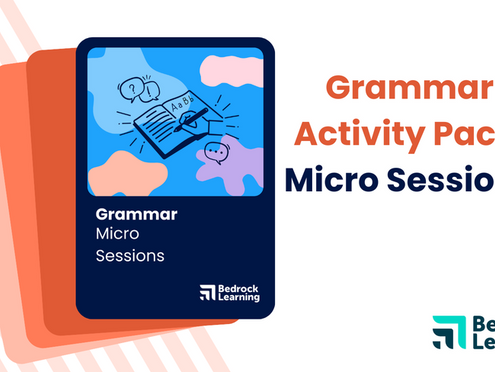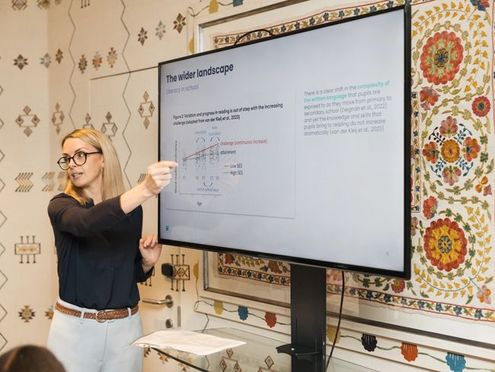Having a sound knowledge of the nuts and bolts of the English language is crucial for success in school. However, understanding and producing the correct grammar is not always easy, and it’s not only students who find it difficult. Even the best teachers can sometimes struggle to adequately answer a learner’s language-related question.
For instance, have you ever thought about why we say absolutely amazing in English, but not absolutely great? Or what the difference in meaning is between “the blue team is winning” and “the blue team are winning?”
For learners struggling with grammar, the likelihood is that they’re having difficulty across multiple subjects. It’s important that issues with grammar are addressed because otherwise, they will continue to affect a learner’s life long after their school years. A good grounding in grammar helps learners gain access to opportunities in further education and employment. Can you remember any times you have deliberated over the punctuation in an important email or on your CV? You’ve likely worried because you know grammar matters; it matters when communicating your ideas, and it matters when making a good first impression to a reader.
In this article, we’re going to look at why knowledge of grammar is vital for good reading comprehension.
What makes a good reader?
In its broadest sense, reading is typically broken down into two major skills: decoding, which is the ability to phonetically produce sounds presented on a page, and comprehension, which involves understanding the meaning of individual words and a text overall. A common misconception is that to understand a text, all a reader needs to do is decode it. However, this is far from the case; there’s a lot more going on in the brain than just decoding. For example, consider a young child who is quietly making sense of a storybook: what mental processes do you think might be taking place? What skills might they be applying?
In Larsen-Freeman’s definition of how readers comprehend text, she writes that “meaning does not reside exclusively in the text, but rather arises through negotiation between the reader and writer” (1986, p.134). What this means is that readers must actively engage with a text and bring to the reading task various skills, which include, but are not limited to, basic world knowledge, vocabulary, and, of course, a solid understanding of grammar.
Let’s move on by exploring three aspects of English grammar that can be challenging for young readers yet are essential for good reading comprehension.
Three grammar skills for reading comprehension
1. Making links and connecting ideas
Cohesion is a term that refers to the way a writer creates links between parts of a text. One way of creating cohesion in a text is to use certain words and phrases. Nuttall (2005) divides such words and phrases into two distinct groups. She identifies words and phrases concerned with ‘signification,’ and words and phrases related to ‘functional value’. Let’s delve further into what these terms mean in practice.
Signification refers to reference words such as pronouns (he, she, you, …) and demonstratives (this, that, these, and those); we typically use these words to avoid repetition. Consider the sentence, “He passes it to her.” There are three pronouns in this sentence – he, it, and her. Without any context, this sentence has no meaning because as readers we’re left asking, who is he? Who is she? What is it? Therefore, one key skill a competent reader possesses is the ability to retrieve references in a text so that they understand sentences with pronouns or demonstratives.
The second group of words and phrases Nuttall identifies is those related to functional value. These are grammatical words technically known as discourse markers and conjunctions. For example, ‘therefore’ is a discourse marker used to indicate a cause-effect relationship between ideas, and ‘whereas’ is a conjunction used to express contrast. As readers, we have to know the function of these words so that we can understand what the writer is doing and how they want us to follow their ideas.
An interesting finding in research on reading in settings where English is a second language is that readers often overlook words that signal functional value. For example, the readers in Ang’s (2014) study and Cohen et al’s (1990) study were shown to have limited comprehension of the texts they read. This was due to them not making the connections between ideas that the writer had intended. The learners didn’t make these links because they didn’t understand the meanings of words that the writers had used to create cohesion.
Strong readers possess a good awareness of the cohesive devices we’ve looked at in this section so that they can make links and create connections whilst reading. They are able to infer references from context and look for clues within texts, such as functional value words, in order to know how a text should be read.

Boost grammar and reading comprehension
Explore hundreds of teaching videos, bespoke texts and literacy-boosting activities, all driven by a unique deep-learning algorithm.
2. Understanding sentence structure
Understanding a text is closely linked to understanding syntax (Nuttall 2005, p.78). Competent readers of English are able to analyse parts of a sentence in order to understand complex grammatical structures. Let’s take an example sentence from Mary Shelley’s Frankenstein, a text learners will typically study at key stage three.
“I feel exquisite pleasure in dwelling on the recollections of childhood, before misfortune had tainted my mind and changed its bright visions of extensive usefulness into gloomy and narrow reflections upon self.”
In order to understand this sentence in its fullest sense, a reader must have a strong grasp of English grammar. They need to identify that the first part of the sentence carries the main message and make sense of this initial clause. In the example above, the first clause is complicated because it includes a heavy noun phrase – dwelling on the recollections of childhood. For a reader to understand what is meant here, they must recognise the head noun in that clause - dwelling - and understand that childhood describes the noun recollections. What we need learners to recognise is that the writer is telling the reader that Frankenstein feels satisfaction when he thinks about his childhood over a long period of time.
The second part of the sentence is equally complex, if not more, with another lengthy noun phrase - “gloomy and narrow reflections upon self.” This time, the reader must recognise that ‘reflections’ is the head noun and that the other parts of the noun phrase are modifying this word - in other words, they provide additional descriptive detail about what these reflections are.
For a reader with weak grammatical skills, Frankenstein, like many other classic texts, can be a challenge to read as the syntactic structures throughout the novel are complex.
3. Recognising uses of punctuation
The last aspect of grammar that we’ll look at is punctuation. We’ll focus on the function of commas when they are used with a rather complicated feature of English grammar known as embedded clauses - parts of a sentence in the middle of a sentence. The role of embedded clauses is to provide a reader with more information. Naturally, novelists use embedded clauses because they provide description and create subtext. Therefore, readers will need a solid understanding of English grammar to appreciate them fully.
This time, let’s take an example sentence from another popular book at key stage three - J.D Salinger’s Catcher in the Rye.
“I suddenly remembered this time, in around October, that I and Robert Tichener and Paul Campbell were chucking a football around, in front of the academic building.”
What is the main idea in this sentence? The narrator remembers that he, Robert Tichener and Paul Campbell were playing with a football. The other parts of the sentence which tell us about the time of year and place are details, not the writer’s key message. We can see here that the use of commas in the sentence separates the embedded clauses; in other words, they separate the details from the main idea.
What this tells us as readers is that the writer wants us to picture and retain this action whilst we continue reading - in this way, we get a better understanding of the meaning of the text from the grammar within it.
How grammar helps interpret the writer’s meaning
Understanding subtext
To fully engage with a novel, it is vital for a reader to identify subtext. Picture for a moment that you have a beautiful necklace in a jewellery box. Maybe you’ve decided to keep the item somewhere safe because it is valuable, or maybe it holds sentiment. This necklace is similar to what we, as readers, do with subtext - we store it in our mind because it provides us with details that offer insight into how a character is feeling, or information that might be valuable later.
Subtext is reading between the lines, and it allows readers to engage with a piece of text on a deep and meaningful level. If a reader does not identify subtext, then they may misinterpret the true intentions of a character or miss something humorous. In the classroom, overlooking subtext can result in learners struggling with higher-order thinking tasks that ask them to critique a piece of writing or make predictions about what is going to happen next.
If a strong understanding of grammar can help a learner develop strong reading skills and engage more effectively with tasks in the classroom, you may now be wondering whether reading comprehension and grammar awareness can also have a positive impact on writing. Let’s explore.
Strong reading skills improve writing
Reading is a receptive skill and writing is a productive skill, and these skills complement one another. Many of the worlds’ most famous authors, such as Stephen King (2005), say that to become a good writer you have to read. There are many reasons why reading helps improve writing; let’s discuss a couple.
Improve complex sentence structure
Strong readers with good comprehension skills can fully understand complex sentences. These sentences often include embedded clauses, heavy noun phrases, subordinating conjunctions such as ‘although’ and ‘whereas,’ and many other complicated grammatical features. After consistent exposure to texts with complex sentences, learners will begin to use them in their own writing.
If they’re writing fiction, for example, they’ll start to include detail about how a character looks or feels in their writing using embedded clauses, knowing it’s important not to distract the reader from the main idea. If they’re writing an essay, they’ll know which words they can use to show how one idea is connected to another idea.
Writers who are strong readers will express themselves clearly and fluently and with increasing technicality and confidence. They will find that the words on the page are effectively matching the ideas in their mind and enjoy the process of writing.
Develop awareness of the reader’s needs
When learners read well and read regularly, they start to acquire a natural understanding of a reader’s needs. For example, when writing fiction, they will be aware of the importance of sequencing actions in a logical way and the need to create cohesion. If writing non-fiction, they’ll be aware of aspects of style; for example, the need for subheadings and structured paragraphs in an essay.
Readers will understand techniques writers use, such as using pronouns to avoid repetition and commas to separate detail from the main idea, and they’ll begin to use these techniques to enhance their own writing.
Discover Bedrock Learning
Sign up to our free trial today to discover how Bedrock Learning can help your students.
What makes a good reader?
We have looked at how a competent reader brings their knowledge of grammar to the reading task. This knowledge includes the ability to understand complex sentences, separate main ideas from details, identify referents, and follow cohesive devices.
Readers must be able to carry out these tasks quickly so that their reading flow is uninterrupted, and they retain necessary information. When a reader has these skills along with others, such as an ability to infer meaning and understand an unknown word from context, they access texts in a meaningful way and become fully absorbed in reading. This positively influences other language areas too, such as broadening vocabulary range, strengthening writing skills, and developing the ability to critique a text.
Ultimately, we should encourage learners to read extensively and, more importantly, to read for pleasure. At the same time, we need to support the development of grammar so that young readers can fully access the texts they read, develop a genuine appreciation for literature, and become confident communicators.
Let’s look at three ways Bedrock Learning assists with teaching grammar and reading in the classroom.
Three ways the Bedrock Learning Programme helps develop reading and grammar, together
1. Learning through texts
Bedrock's grammar curriculum exposes learners to English grammar through an array of original fiction and non-fiction texts. Grammar topics are presented to learners in the context of a story, which makes the learning fun and interactive and encourages a real passion for reading.
Research has long shown that learners acquire language best when using authentic materials; therefore, original texts are used to promote learning. Bedrock's grammar curriculum offers a wide variety of texts, suitable for all abilities, and teaches a range of grammar topics, including sentence structure and punctuation.
2. Engaging video teaching
After learners have read a book, they are then presented with a short teaching video that presents an aspect of grammar. The content is delivered in an engaging and easy-to-understand way that learners enjoy, and it is set in the context of the title they’ve just read.
In order to acquire language, research has shown that learning needs to be scaffolded in a way that gradually leads to a learner working independently. The goal of Bedrock’s videos is to prepare learners for follow-up activities in which they will work independently on a grammar point and complete a variety of meaningful and purposeful tasks.
3. Range of learning activities
The learning activities designed by Bedrock give learners an opportunity to apply their knowledge and develop a deeper understanding of the grammar topic they have been studying. The grammar activities are easy for the teacher to deliver, and there are plenty to choose from. For example, learners might work on looking at the effect writer’s choice has on grammar or complete a range of writing and self-editing tasks.
The learning doesn’t stop there. Teachers can also give learners optional practice activities to further deepen their understanding of the grammar they’ve been working on in class.




